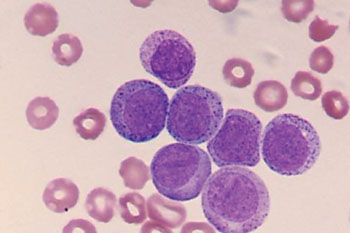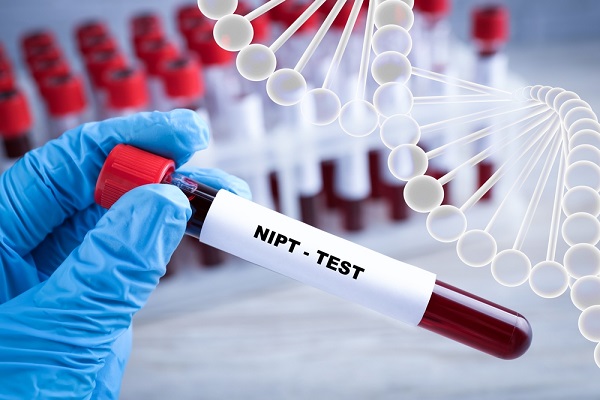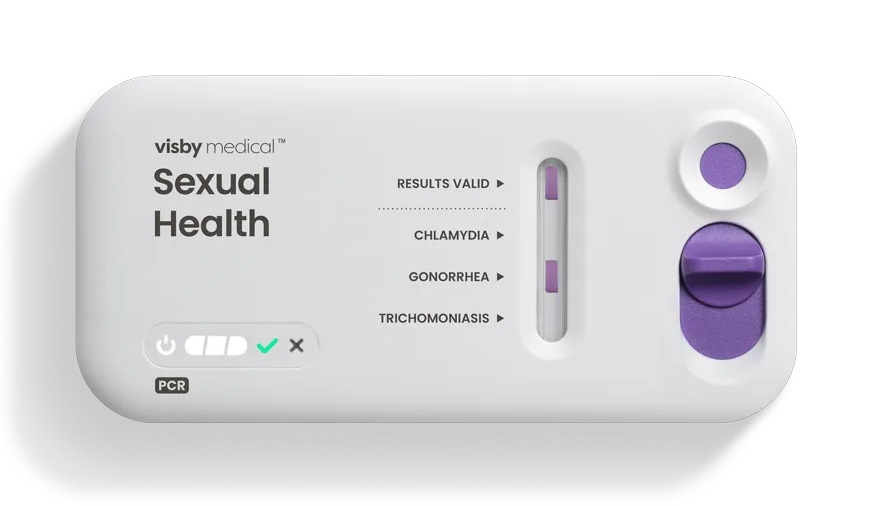Blood Test Improves Treatment for Acute Myeloid Leukemia
|
By LabMedica International staff writers Posted on 10 Feb 2016 |

Image: Peripheral blood smear of a patient with acute myeloid leukemia (Photo courtesy of Dr. Abbas H. Abdulsalam).

Image: The HaloPlex Target Enrichment Kit for next-generation sequencing (Photo courtesy of Agilent Technologies).
A simple blood test has been developed that is capable of detecting trace levels of leukemia cells remaining after intensive chemotherapy. The test can predict which patients with acute myeloid leukemia (AML) are at risk of their cancer returning in the future, helping to guide doctors on what further treatment is needed.
AML is a type of blood cancer diagnosed in around 2,400 people each year in the UK and survival rates are extremely poor, with fewer than 2 in 10 patients surviving for more than five years. The leukemia can be cured in patients who are able to tolerate intensive treatment and the prognosis is better in these patients.
A large team of scientists led by those at the UK National Institute for Health Research (London, UK) enrolled patients in a trial from April 6, 2009, to December 31, 2014. Centralized molecular screening identified patients with nucleophosmin (NPM1) mutations. Follow-up samples were scheduled to be obtained at the time of blood-count regeneration after each cycle of treatment and then quarterly until 24 months after consolidation therapy. Samples that were obtained at early time points (i.e., on regeneration after induction and consolidation cycles) were mostly samples of peripheral blood, since the evaluation of bone marrow was prioritized for flow cytometry.
The team detected minimal residual disease (MRD) on reverse-transcriptase quantitative polymerase chain reaction (RT-qPCR) using a mutation-specific primer with a common primer and probe. Assays were run in triplicate on the ABI 7900 platform (Applied Biosystems; Foster City, CA, USA) and mutated transcript levels were compared to expression of a reference gene with the use of plasmid standards with the difference-in-cycle-thresholds method used for rare mutations. High-throughput sequencing with the use of HaloPlex Target Enrichment (Agilent Technologies; Santa Clara, CA, USA) was performed on the HiSeq 2000 (Illumina; San Diego, CA, USA).
The scientists found that MRD testing was far superior at predicting relapse compared to current methods, which mainly rely on analysis of genetic abnormalities within individual patients' cancer cells that influence whether they are “high risk” or “low risk” at the start of treatment. The MRD test can determine if a patient is in “molecular remission,” which means there are no signs of the faulty genes indicative of leukemia cells in their blood. In 82% of cases in which the MRD test detected the presence of the NPM1 cancer gene in a blood sample taken after initial treatment, the patient had relapsed within three years. Only 30% of patients who had no detectable leukemia cells in their blood at this stage went on to relapse within that time.
David Grimwade, PhD, a professor and principal investigator of the study said, “Conventional methods for guiding treatment for this aggressive type of leukemia are inadequate. The MRD test is an invaluable tool to assess treatment response and identify those patients for whom chemotherapy is not sufficient and require stem cell transplantation or new treatments.” The study was published on January 20, 2016, on the journal the New England Journal of Medicine (NEJM).
Related Links:
UK National Institute for Health Research
Applied Biosystems
Agilent Technologies
AML is a type of blood cancer diagnosed in around 2,400 people each year in the UK and survival rates are extremely poor, with fewer than 2 in 10 patients surviving for more than five years. The leukemia can be cured in patients who are able to tolerate intensive treatment and the prognosis is better in these patients.
A large team of scientists led by those at the UK National Institute for Health Research (London, UK) enrolled patients in a trial from April 6, 2009, to December 31, 2014. Centralized molecular screening identified patients with nucleophosmin (NPM1) mutations. Follow-up samples were scheduled to be obtained at the time of blood-count regeneration after each cycle of treatment and then quarterly until 24 months after consolidation therapy. Samples that were obtained at early time points (i.e., on regeneration after induction and consolidation cycles) were mostly samples of peripheral blood, since the evaluation of bone marrow was prioritized for flow cytometry.
The team detected minimal residual disease (MRD) on reverse-transcriptase quantitative polymerase chain reaction (RT-qPCR) using a mutation-specific primer with a common primer and probe. Assays were run in triplicate on the ABI 7900 platform (Applied Biosystems; Foster City, CA, USA) and mutated transcript levels were compared to expression of a reference gene with the use of plasmid standards with the difference-in-cycle-thresholds method used for rare mutations. High-throughput sequencing with the use of HaloPlex Target Enrichment (Agilent Technologies; Santa Clara, CA, USA) was performed on the HiSeq 2000 (Illumina; San Diego, CA, USA).
The scientists found that MRD testing was far superior at predicting relapse compared to current methods, which mainly rely on analysis of genetic abnormalities within individual patients' cancer cells that influence whether they are “high risk” or “low risk” at the start of treatment. The MRD test can determine if a patient is in “molecular remission,” which means there are no signs of the faulty genes indicative of leukemia cells in their blood. In 82% of cases in which the MRD test detected the presence of the NPM1 cancer gene in a blood sample taken after initial treatment, the patient had relapsed within three years. Only 30% of patients who had no detectable leukemia cells in their blood at this stage went on to relapse within that time.
David Grimwade, PhD, a professor and principal investigator of the study said, “Conventional methods for guiding treatment for this aggressive type of leukemia are inadequate. The MRD test is an invaluable tool to assess treatment response and identify those patients for whom chemotherapy is not sufficient and require stem cell transplantation or new treatments.” The study was published on January 20, 2016, on the journal the New England Journal of Medicine (NEJM).
Related Links:
UK National Institute for Health Research
Applied Biosystems
Agilent Technologies
Latest Molecular Diagnostics News
- Ultra-Sensitive Blood Test Predicts Breast Cancer Recurrence Months or Even Years before Relapse
- Prenatal Testing Offers Window for Finding Mother’s Cancer Risk
- New Molecular Test Detects More Cervical Cancer Cases
- New Panel Quickly and Accurately Identifies 16 Common Gastrointestinal Pathogens
- New DNA Testing Method Offers Faster and More Accurate Pathogen Identification
- Precise Cancer Detection Method as Quick and Easy as Blood Test
- DNA Spit Test More Accurate At Identifying Future Prostate Cancer Risk
- Novel Method Combining Nano Informatics and AI Paves Way for Cancer Blood Tests
- Groundbreaking Molecular Diagnostic Kit to Provide Lyme Disease Detection in Minutes
- New Assay Detects Heart Failure Biomarker in Less than 11 Minutes
- Innovative Test Improves Assessment of Patients with Mild Traumatic Brain Injury
- New Method for Lung Microbiomes Analysis Predicts Mortality in Children after Bone Marrow Transplant
- Novel Technique Detects Biomarkers for Kidney Diseases with Nephritic Syndrome
- Lipoprotein Blood Test Detects Hereditary Cardiovascular Risk
- Whole Genome Sequencing Detects Infection Transmission in NICU
- Novel Inexpensive, Shelf-Stable, Easy To Use Tests Bring Lab-Level Precision at POC
Channels
Clinical Chemistry
view channel
New ADLM Guidance Provides Expert Recommendations on Clinical Testing For Respiratory Viral Infections
Respiratory tract infections, predominantly caused by viral pathogens, are a common reason for healthcare visits. Accurate and swift diagnosis of these infections is essential for optimal patient management.... Read more
3D Printed Point-Of-Care Mass Spectrometer Outperforms State-Of-The-Art Models
Mass spectrometry is a precise technique for identifying the chemical components of a sample and has significant potential for monitoring chronic illness health states, such as measuring hormone levels... Read more.jpg)
POC Biomedical Test Spins Water Droplet Using Sound Waves for Cancer Detection
Exosomes, tiny cellular bioparticles carrying a specific set of proteins, lipids, and genetic materials, play a crucial role in cell communication and hold promise for non-invasive diagnostics.... Read more
Highly Reliable Cell-Based Assay Enables Accurate Diagnosis of Endocrine Diseases
The conventional methods for measuring free cortisol, the body's stress hormone, from blood or saliva are quite demanding and require sample processing. The most common method, therefore, involves collecting... Read moreMolecular Diagnostics
view channel.tmb-0945x532.jpg)
Ultra-Sensitive Blood Test Predicts Breast Cancer Recurrence Months or Even Years before Relapse
Breast cancer cells can linger in the body after surgery and other treatments, sometimes in such low quantities that follow-up scans fail to detect them. These cells can cause a recurrence of breast cancer... Read more
Prenatal Testing Offers Window for Finding Mother’s Cancer Risk
Harmful variants in the BRCA1 gene significantly increase an individual's lifetime risk of developing breast, ovarian, and pancreatic cancers, yet most carriers are unaware of their status.... Read moreImmunology
view channel.jpg)
AI Tool Predicts Cancer Patients’ Response to Immunotherapy
Immune checkpoint inhibitors are a form of immunotherapy drug that enables immune cells to target and destroy cancer cells. At present, the Food and Drug Administration has approved two predictive biomarkers... Read more
Molecular Profiling Improves Diagnosis for Children with High Risk Cancers
Cancer remains the leading cause of disease-related death among children in most developed nations, and approximately one-fourth of these patients are diagnosed with aggressive, high-risk, or relapsed... Read moreMicrobiology
view channel
POC STI Test Shortens Time from ED Arrival to Test Results
In a 2024 sexually transmitted infections (STIs) surveillance report by the World Health Organization (WHO), over 2.5 million cases were recorded, alongside a rise in the inappropriate use of antibiotics... Read more
Integrated Solution Ushers New Era of Automated Tuberculosis Testing
Tuberculosis (TB) is responsible for 1.3 million deaths every year, positioning it as one of the top killers globally due to a single infectious agent. In 2022, around 10.6 million people were diagnosed... Read more
Automated Sepsis Test System Enables Rapid Diagnosis for Patients with Severe Bloodstream Infections
Sepsis affects up to 50 million people globally each year, with bacteraemia, formerly known as blood poisoning, being a major cause. In the United States alone, approximately two million individuals are... Read moreEnhanced Rapid Syndromic Molecular Diagnostic Solution Detects Broad Range of Infectious Diseases
GenMark Diagnostics (Carlsbad, CA, USA), a member of the Roche Group (Basel, Switzerland), has rebranded its ePlex® system as the cobas eplex system. This rebranding under the globally renowned cobas name... Read morePathology
view channel
AI Tool Detects Tiny Protein Clumps in Microscopy Images in Real-Time
Over 55 million individuals worldwide suffer from dementia-related diseases like Alzheimer's and Parkinson's. These conditions are caused by the clumping together of the smallest building blocks in the... Read more
New Tool Enables Better Classification of Inherited Disease-Causing Variants
Whole genome and exome sequencing are increasingly available for clinical research, aiding in the detection of inherited genetic variants that may cause various diseases. The American College of Medical... Read more
Groundbreaking CRISPR Screen Technology Rapidly Determines Disease Mechanism from Tissues
Thanks to over a decade of advancements in human genetics, scientists have compiled extensive lists of genetic variations linked to a wide array of human diseases. However, understanding how a gene contributes... Read moreTechnology
view channel
Microneedle Patch Detects Skin Cancer Early
Wearable bioelectronics has emerged as a significant innovation in healthcare, especially in the field of biosensing, providing a new method to monitor individual health for both diagnostic and therapeutic purposes.... Read more
New Diagnostic System Achieves PCR Testing Accuracy
While PCR tests are the gold standard of accuracy for virology testing, they come with limitations such as complexity, the need for skilled lab operators, and longer result times. They also require complex... Read moreIndustry
view channel
Roche and Hitachi High-Tech Extend 46-Year Partnership for Breakthroughs in Diagnostic Testing
Roche (Basel, Switzerland) and Hitachi High-Tech (Tokyo, Japan) have renewed their collaboration agreement, committing to a further 10 years of partnership. This extension brings together their long-standing... Read more
Danaher and Johns Hopkins University Collaborate to Improve Neurological Diagnosis
Unlike severe traumatic brain injury (TBI), mild TBI often does not show clear correlations with abnormalities detected through head computed tomography (CT) scans. Consequently, there is a pressing need... Read more
Beckman Coulter and MeMed Expand Host Immune Response Diagnostics Partnership
Beckman Coulter Diagnostics (Brea, CA, USA) and MeMed BV (Haifa, Israel) have expanded their host immune response diagnostics partnership. Beckman Coulter is now an authorized distributor of the MeMed... Read more_1.jpg)











_2.jpeg)


.jpg)



